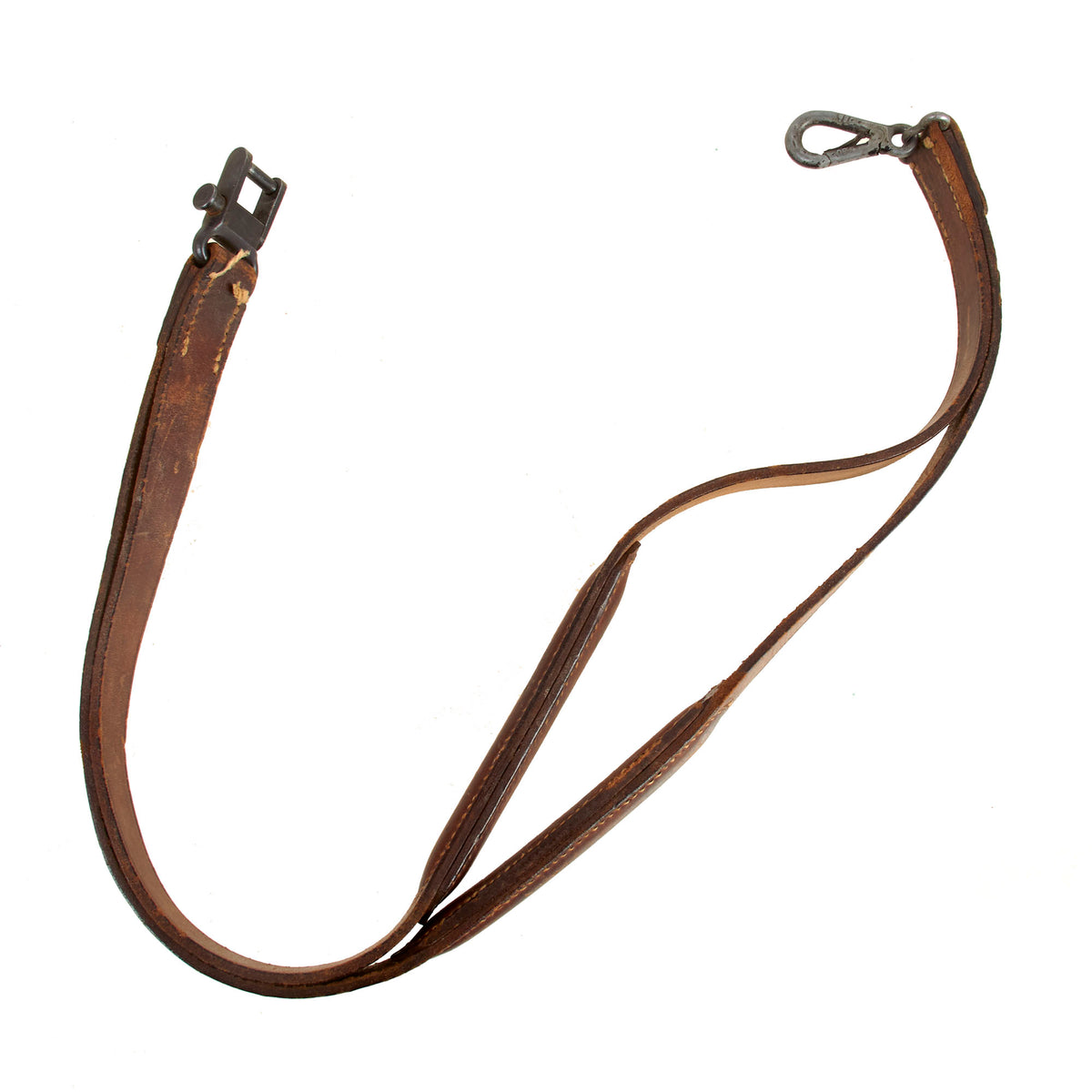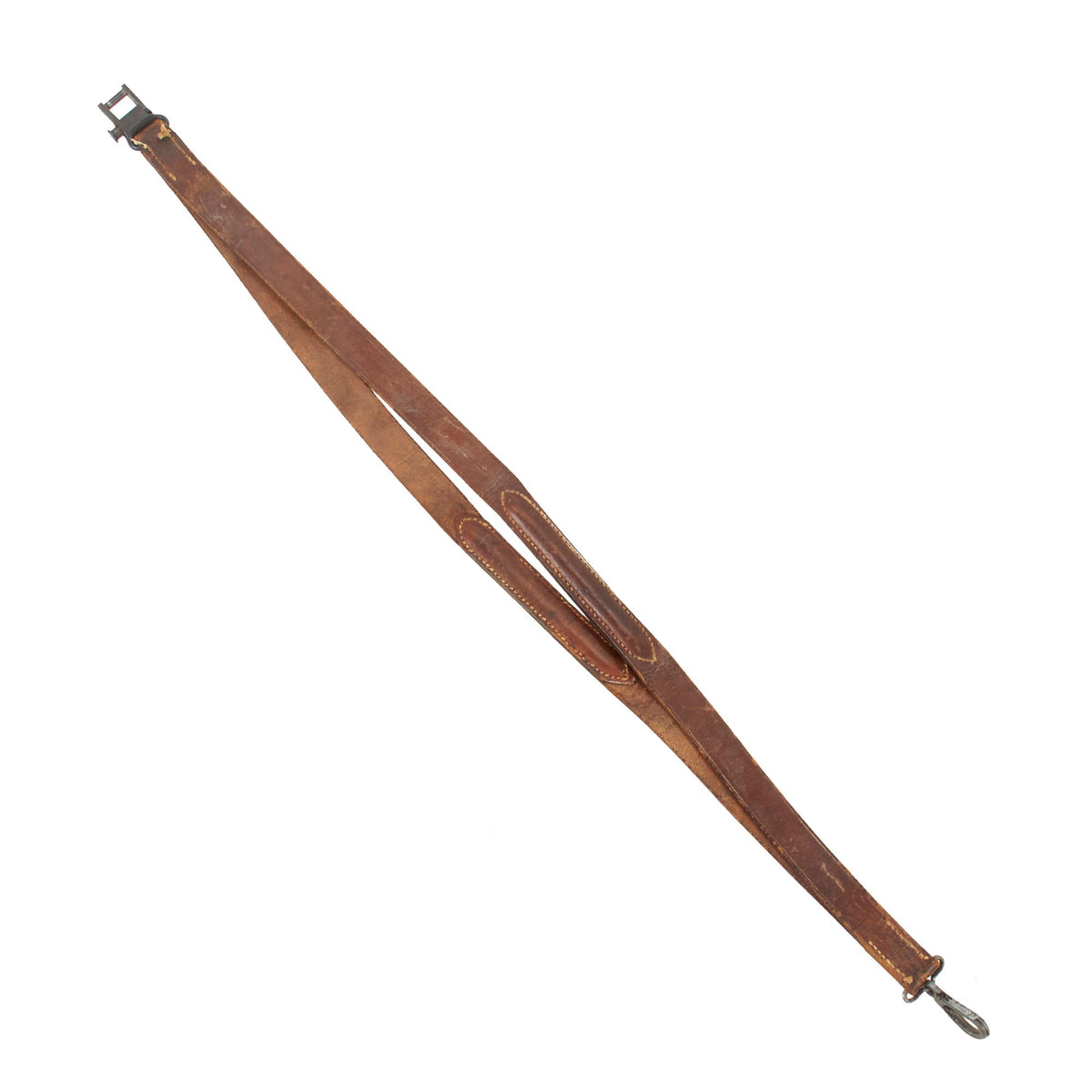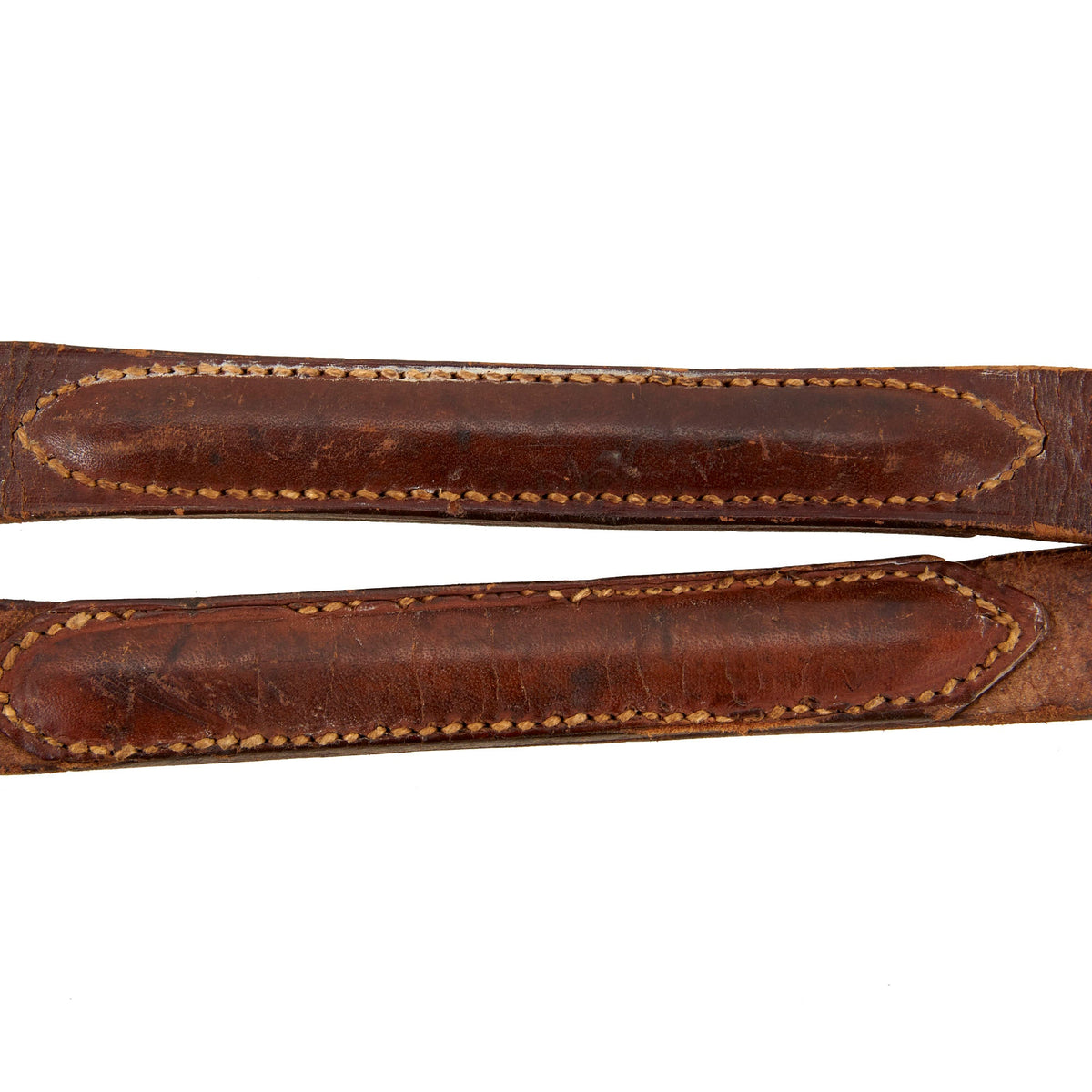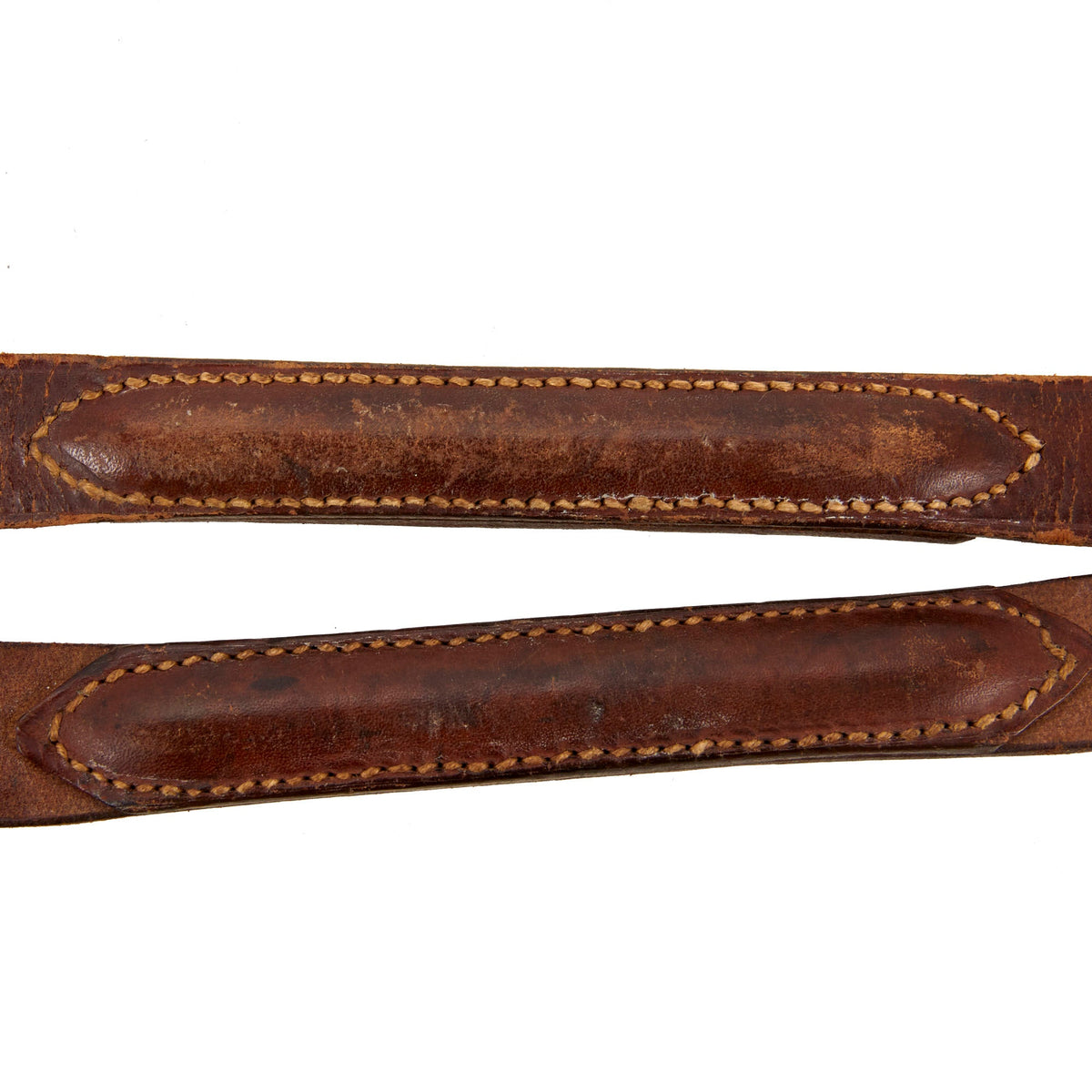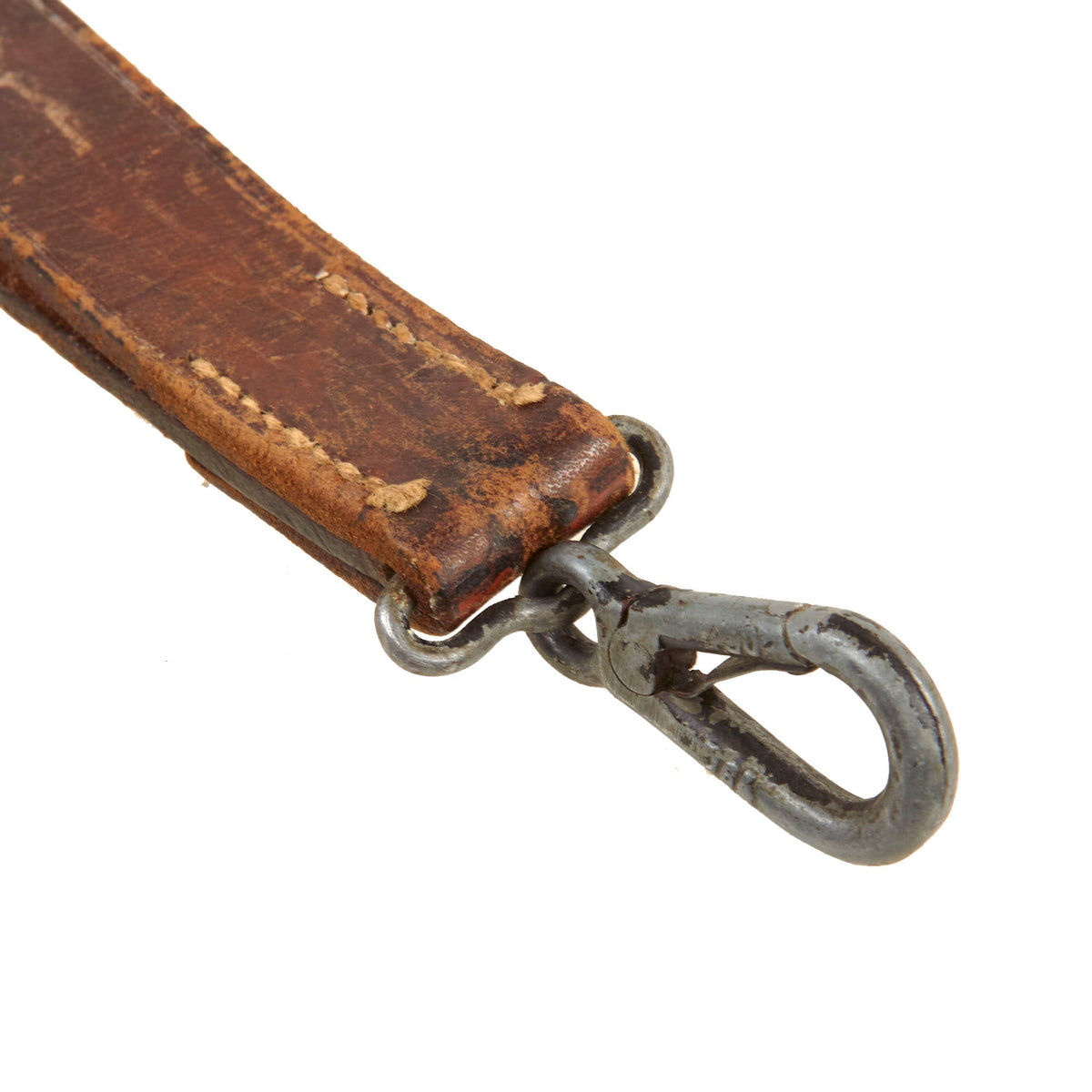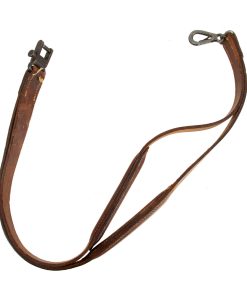Original German WWII First Model MG 34 Padded Leather Carry Sling with Narrow Buckle – Geteilte Trageriemen Original Items
$ 350,00 $ 105,00
Original Item: Only One Available. The leather sling that was issued with the MG 34 was constructed from two straps with a padded middle section, sewn together at each end. The sling served several purposes. It could be used to carry the machine gun in the traditional way, suspended over the shoulder, it could act as a carrying handle when split on each side of the gun and joined together at the top and it could also be used as a support when firing the MG from the hip during advancement.
The German name for the sling was simply Geteilte Trageriemen (Divided carrying sling). The sling later issued for the MG42 was almost identical to the MG34, except for the grip buckle. Production was either done by the same factories that made the gun or separate manufacturers. The BSW factory made a wide range of different MG34/42 items, like ammunition belts and starter tabs, buckles for the slings and even complete slings.
The front buckle came in three different models. The first model buckle had a separate spring and was usually unmarked or marked with S↑C (Schmöle & Co, Menden / Sauerland) marked, though some also have some cast number markings, such as this example. The second model had an integrated spring and was always unmarked. The third model had a simplified buckle and was usually found on “bla 1943” and “bla 1944” marked slings.
The rear buckle is the real difference between the Mg34 and MG34/42 sling. The first model of the buckle was too narrow to fit the MG42 handle, so a new sling buckle had to be designed. The MG42 sling will fit both grips, although fits a little loose on the MG34, while the MG34 buckle will not close properly on the MG42 grip, as the grip is too wide with the buckle too narrow. This example has the Narrow Buckle for the MG 34 and was seen being produced from 1936 – 1943. If fitted to an MG 42 the buckle will not close correctly.
This is truly a lovely example of an MG 34 sling, offered in serviceable condition, showing light wear to the leather from use and age. Comes ready to be fitted to your MG 34 Display guns!
The Maschinengewehr 34, or MG 34, is a German recoil-operated air-cooled machine gun, first tested in 1929, introduced in 1934, and issued to units in 1936. It accepts the 7.92×57mm Mauser cartridge, and is generally considered the world’s first general-purpose machine gun.
The versatile MG 34 was arguably the most advanced machine gun in the world at the time of its deployment. Its combination of exceptional mobility – being light enough to be carried by one man – and high rate of fire (of up to 900 rounds per minute) was unmatched. It entered service in great numbers following AH’s repudiation of the Versailles Treaty in 1936, and was first combat tested by German troops aiding Franco’s Nationalists in the Spanish Civil War. Nonetheless, the design proved too complex for mass production, and was supplemented by the cheaper and simpler MG 42, though both remained in service and production until the end of the war.
History
The MG 34 was based on a 1930 Rheinmetall design, the MG 30. The Swiss and Austrian militaries had both licensed and produced the MG 30 from Rheinmetall shortly after patent. The MG 30 design was adapted and modified by Heinrich Vollmer of Mauser Industries. Vollmer modified the feed mechanism to accept either drum magazines or belt ammunition. He also increased the rate of fire. The MG 34’s double crescent trigger dictated either semiautomatic or fully automatic firing modes.
In the field, the weapon could operate in offensive or defensive applications. The offensive model, with a mobile soldier, used a drum magazine that could hold either 50 or 75 rounds of ammunition. In a stationary defensive role, the gun was mounted on a bipod or tripod and fed by an ammunition belt. Belts were carried in boxes of five. Each belt contained 50 rounds. Belt lengths could be linked for sustained fire. During sustained fire, barrels would have to be changed at intervals due to the heat generated by the rapid rate of fire. If the barrels were not changed properly, the weapon would misfire. Changing barrels was a rapid process for the trained operator and involved disengaging a latch and swinging the receiver to the right for the insertion of a new barrel. Accordingly, stationary defensive positions required more than one operator.
The MG 34 was the mainstay of German Army support weapons from the time of its first issue in 1935 until 1942, when it was supplanted by the next generation Maschinengewehr 42 or MG 42. Although the 34 was very reliable and dominant on the battlefield, its dissemination throughout the German forces was hampered due to its precision engineering, which resulted in high production costs and a relatively slower rate of production. For its successor, the MG 42, the Germans instead used mass production techniques similar to those that created the MP 40 submachine gun. However, the Germans nevertheless continued widespread production of MG 34s until the end of the war.
The MG 34 was used as the primary infantry machine gun during the 1930s, and remained as the primary armored vehicle defensive weapon. It was to be replaced in infantry service by the related MG 42, but there were never enough quantities of the new design to go around, and MG 34s soldiered on in all roles until the end of World War II. The MG 34 was intended to replace the MG 13 and other older machine guns, but these were still being used in World War II as demand was never met.
It was designed primarily by Heinrich Vollmer from the Mauser Werke, based on the recently introduced Rheinmetall-designed Solothurn 1930 (MG 30) that was starting to enter service in Switzerland. Changes to the operating mechanism improved the rate of fire to between 800 and 900 rpm.
The new gun was accepted for service almost immediately and was generally liked by the troops, and it was used to great effect by German soldiers assisting Nationalist Spain in the Spanish Civil War. At the time it was introduced, it had a number of advanced features and the general-purpose machine gun concept that it aspired to was an influential one. However, the MG 34 was also expensive, both in terms of construction and the raw materials needed (49 kg (108.0 lb) of steel),[citation needed] and its manufacture was too time-consuming to be built in the numbers required for the ever-expanding German armed forces. It was the standard machine gun of the Kriegsmarine (German navy).
Fast Shipping with Professional Packaging
Thanks to our longstanding association with UPS FedEx DHL, and other major international carriers, we are able to provide a range of shipping options. Our warehouse staff is expertly trained and will wrap your products according to our exact and precise specifications. Prior to shipping, your goods will be thoroughly examined and securely secured. We ship to thousands clients each day across multiple countries. This shows how we're dedicated to be the largest retailer on the internet. Warehouses and distribution centres can be located throughout Europe as well as the USA.
Note: Orders with more than one item will be assigned a processing date depending on the item.
Before shipping before shipping, we'll conduct a thorough inspection of the items you have ordered. Today, the majority of orders will be delivered within 48 hours. The delivery time will be between 3-7 days.
Returns
The stock is dynamic and we cannot completely manage it because multiple stakeholders are involved, including our factory and warehouse. So the actual stock may alter at any time. It's possible that you may not receive your order once the order has been made.
Our policy is valid for a period of 30 days. If you don't receive the product within 30 days, we are not able to issue a refund or an exchange.
You can only return an item if it is unused and in the same state as the day you received it. You must have the item in its original packaging.
Related products
Uncategorized
Uncategorized
Uncategorized
Uncategorized
Band of Brothers ORIGINAL GERMAN WWII Le. F.H. 18 10.5cm ARTILLERY PIECE Original Items
Uncategorized
Uncategorized
Uncategorized
Uncategorized
Uncategorized
Uncategorized
Uncategorized
Uncategorized
Uncategorized
Uncategorized
Uncategorized
Uncategorized
Uncategorized
